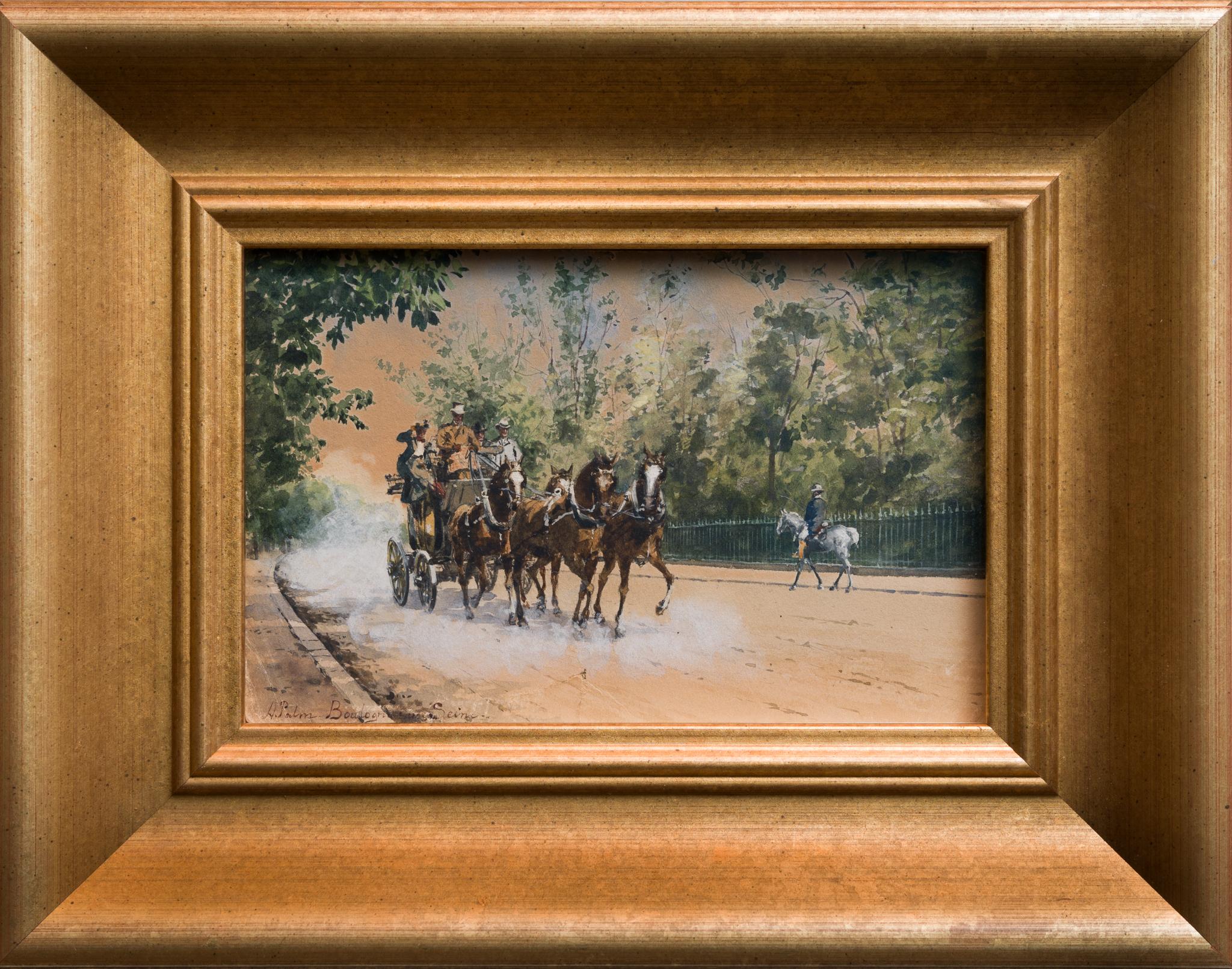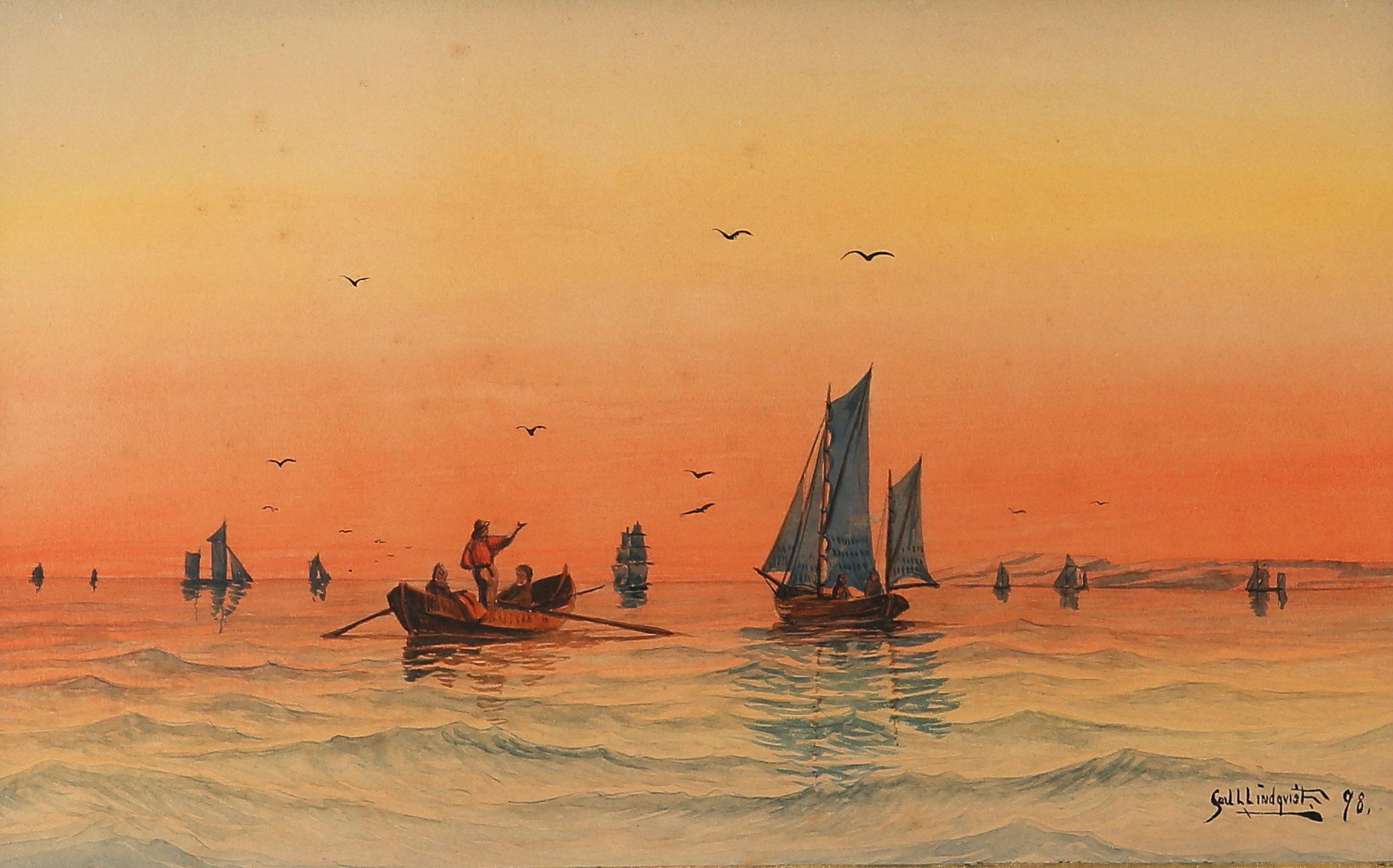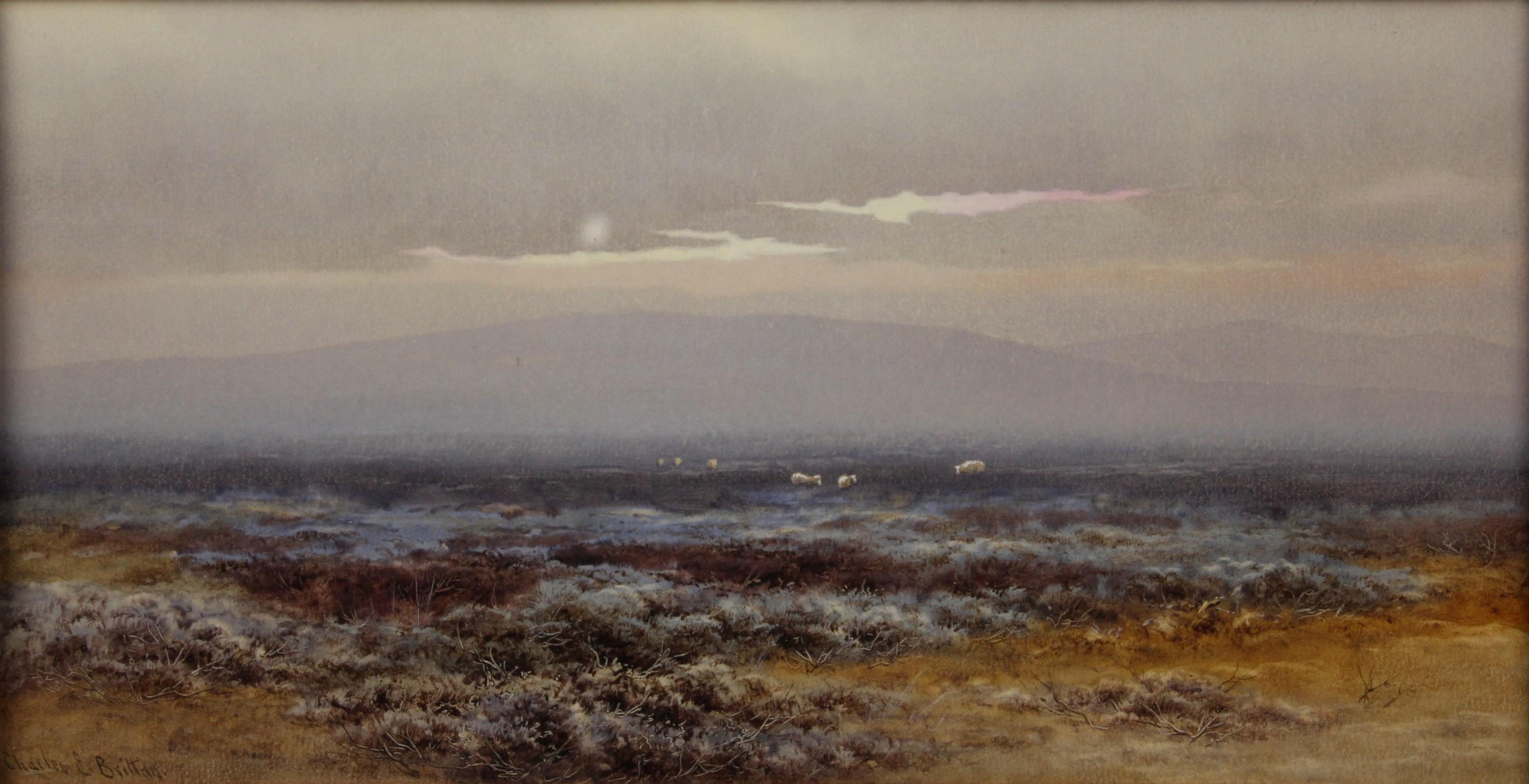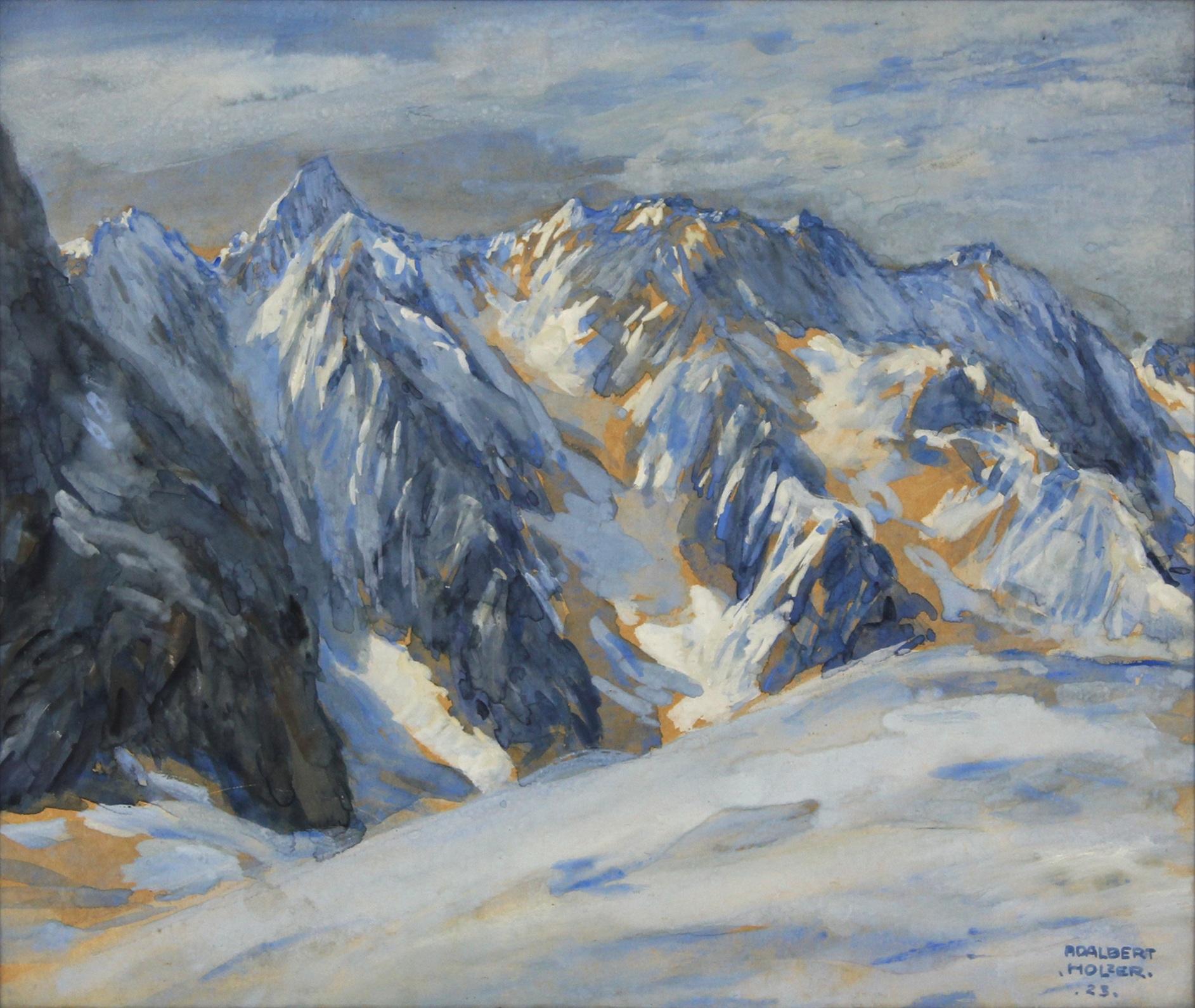Items Similar to Shady hollow way - Into the heart of the forest -
Want more images or videos?
Request additional images or videos from the seller
1 of 8
Hans DvoràkShady hollow way - Into the heart of the forest -1888
1888
About the Item
Hans Dvořák (19th century). Shady hollow way in a sunny forest. Watercolour and pen-and-ink drawing, 58.5 x 43 cm (visible size), 70 x 55.5 cm (frame), signed and dated "Hans Dvořák [18]88" at lower left.
Framed under glass.
- Into the heart of the forest -
About the artwork
This large watercolour depicts a sparse forest landscape in the glaring light of the midday sun. Immediately in front of the viewer, a stream crosses the path, its refreshing coolness accentuated by the surrounding shadows. Beyond the stream, the terrain is brightly lit. Here, the water-logged plants are in full bloom, while the pile of wood, faded by the strong sun, has taken on the grey colour of the rocky ground, contrasting with the green of the foliage. Between the green carpet of leaves on the left and the pile of wood on the right is the mouth of a slightly ascending, tunnel-like vaulted path, which leads out again into the bright summer sun, so that the light blue background of the sky illuminates the dark forest passage from behind.
The sequence of light and shadow, from the shadow of the immediate foreground into the light, from the light back into the shadow and from there back into the foreseeable light, gives the picture a strong narrative dimension, supported by the timeless atmosphere of the noon hour. And yet, following the panta rhei of the stream, time passes. The leaves of the delicate tree standing next to the pile of dead wood have already taken on a slight autumnal hue. The picture's oscillation between narrative and atmosphere is also to be found at the level of artistic creation: the representational quality, clearly outlined with the pencil, fades into a diffuse atmosphere through the character of the watercolour. The picture is both luminous and mysterious.
With this work, Hans Dvorak has created a close-up landscape inspired by plein air painting, whose intense appeal is rooted in the 'naturalistic allegory' established by Romantic landscape painting. In this way, Dvorak is at the height of traditional landscape painting, which reached its peak in the late 19th century and was associated with the unfathomable creation.
GERMAN VERSION
Hans Dvořák (19. Jh.). Schattiger Hohlweg in einem sonnigen Wald. Aquarell und Feder, 58,5 x 43 cm (Sichtmaß), 70 x 55,5 cm (Rahmen), links unten signiert und datiert „Hans Dvořák [18]88“.
Unter Glas gerahmt.
- Ins Innerste des Waldes -
zum Werk
Das großformatige Aquarell zeigt eine lichte Waldlandschaft im gleißenden Licht der Mittagssonne. Unmittelbar vor dem Betrachter quert ein Bach den Weg, dessen erfrischende Kühle durch die umgebenden Schatten noch hervorgehoben wird. Jenseits des Bachlaufs ist das Gelände hell beschienen. Hier präsentieren sich die bodennahen, vom Wasser gespeisten Gewächse in ihrer ganzen vegetativen Kraft, während das aufgeschichtete, von der starken Sonne ausgeblichene Holz die gräuliche, mit dem Grün des Blattwerks kontrastierende Farbe des felsigen Bodens angenommen hat. Zwischen dem grünen Blätterteppich links und dem Holzstapel rechts liegt die Mündung eines leicht ansteigenden, tunnelartig überwölbten Weges, der abermals in die lichte Sommersonne hinausführt, so dass der hellblaue Fond des Himmels die dunkle Waldpassage von hinten durchleuchtet.
Die vom Schatten des unmittelbaren Bildvordergrundes ins Lichte, vom Lichten erneut ins Verschattete und von dort wieder ins erahnbare Licht führende Licht-Schatten-Abfolge verleiht dem Bild eine stark erzählerische Dimension, die von der zeitlosen Atmosphäre der mittäglichen Stunde getragen wird. Und doch verfließt - dem panta rhei des Baches folgend - die Zeit. Die Blätter des neben dem Stapel abgestorbenen Holzes stehenden zarten Baumes haben bereits eine leichte herbstliche Einfärbung angenommen. Das Changieren des Bildes zwischen Erzählung und Atmosphäre findet sich auch auf der Ebene der künstlerischen Formierung: Die mit der Feder klar konturierte Gegenständlichkeit verschwebt durch den Charakter des Aquarelles ins Diffus-Atmosphärische. Das Bild ist durchlichtet und geheimnisvoll zugleich.
Mit diesem Werk hat Hans Dvorak ein an der plein air Malerei inspiriertes nahsichtiges Landschaftbild geschaffen, dessen intensive Anziehungskraft in der ‚naturalistischen Allegorie‘ wurzelt, wie sie von der Landschaftsmalerei der Romantik begründet worden ist. Damit bewegt sich Dvorak ganz auf der Höhe der im späten 19. Jahrhundert zur letzten Blüte gebrachten, auf die unergründliche Schöpfung bezogenen traditionellen Landschaftsmalerei.
- Creator:Hans Dvoràk (activ from 1880 - 1915, Austrian)
- Creation Year:1888
- Dimensions:Height: 23.23 in (59 cm)Width: 16.93 in (43 cm)
- Medium:
- Movement & Style:
- Period:
- Condition:
- Gallery Location:Berlin, DE
- Reference Number:1stDibs: LU2438212325792

About the Seller
5.0
Vetted Seller
These experienced sellers undergo a comprehensive evaluation by our team of in-house experts.
Established in 2014
1stDibs seller since 2023
7 sales on 1stDibs
Typical response time: 7 hours
- ShippingRetrieving quote...Ships From: Berlin, Germany
- Return PolicyA return for this item may be initiated within 14 days of delivery.
More From This SellerView All
- Red blooming war landscape with dead soldier - Bleeding flowers -Located in Berlin, DEJohannes Friedrich Heinrich Hänsch (1875-1945), Red blooming war landscape with dead soldier, 1918. Watercolor and gouache on paper, 15 x 24.5 cm (image), 27 x 37 cm (sheet size / frame), monogrammed and dated "19JH18" at lower left. - Paper slightly darkened About the artwork Despite the relatively small format, the watercolor with an internal frame depicts a panoramic view of a flat landscape stretching to the horizon. As far as the eye can see, the poppies bloom in flaming red. The flowers are not rendered individually, however, creating an almost cohesive red surface. The bright red is interspersed with vegetal green. A complementary contrast that creates an intense color effect. In this color contrast, a white area breaks through from the middle ground, widening towards the foreground and surrounding a brown hole. Next to it, in blue, is the actual protagonist of the painting, the first thing that catches the eye: a dead soldier. Next to him is his helmet, revealing the empty interior. The brown, hollow shape corresponds to the hole in the ground. A shell funnel is surrounded by bright ash, which, like the inverted helmet, becomes a sign of death. The soldier's arms point to the funnel, while the empty helmet paraphrases the calotte of the skull and, like the funnel, thematizes the empty darkness of death. The soldier's body, however, is intact and not - as in Otto Dix's triptych "The War" - a dismembered corpse. Instead, Johannes Hänsch activates the landscape, especially the color, to illustrate a blooming landscape of death that extends from the shell funnel in the foreground to the rising column of smoke on the horizon. If the soldier's body is intact, the tangle of barbed wire emblematically placed over the empty helmet also appears tattered. On the right side of the picture, the barbed wire even seems to stretch its arms to the sky in horror. Against the background of this allegory, the content of the bright red also becomes clear: the landscape is drenched in blood, literally a sea of blood, and the single unknown soldier stands pars pro toto for all those who died on the battlefield. Dying in war is not dying in community, but in solitude. In order to emphasize the isolation in death, Johannes Hänsch has set the blue of the soldier in the axis given by his body in the middle ground of the picture into the red sea. A master of landscape painting, Hänsch succeeds in creating a natural-looking landscape allegory that illustrates the horror and death of war, without depicting the brutality of war itself. This singular 'war memorial' of the unknown soldier is the opposite of heroization and yet the dignity of the deceased soldier is preserved through the integrity of his body. About the artist As the son of the sculptor Adolf Haensch, the young Johannes received his first artistic training in his father's Berlin studio. However, he eventually decided to become a painter, and in 1897 he entered the Berlin Academy of Arts. He initially studied under Paul Vorgang and Eugen Bracht, and was particularly influenced by Bracht's increasingly colourful landscape painting. In 1901 he moved to the class of Friedrich Kallmorgen, with whom he spent several weeks on excursions into nature. In 1905 he became a master pupil of Albert Hertel, who taught him watercolour painting. From 1903 to 1933 he exhibited annually at the Great Berlin Art Exhibition, the exhibitions of the Berlin Artists' Association and the Munich Glaspalast. In 1905 he was awarded the Carl Blechen...Category
1910s Realist Figurative Drawings and Watercolors
MaterialsWatercolor
- High Moorland Landscape in the fog - The world as a transcendent phenomenon -Located in Berlin, DECharles Edward Brittan Jr (1870 Plymouth - 1949). High moor landscape in the fog. Gouache, signed at lower left "Charles E. Brittan", 18 x 34.5 cm (passepartout), 45 x 62 cm (frame)....Category
Early 20th Century Realist Landscape Drawings and Watercolors
MaterialsWatercolor
- Wettersteinkamm - The blue of the mountains -Located in Berlin, DEAdalbert Holzer (1881 Munich - 1966 Munich). Wettersteinkamm. Watercolour, 29 x 34.5 cm (visible size), 37.5 x 43 cm (frame), signed and dated at lower right 'ADALBERT HOLZER [19]23'. Framed behind glass. Frame shows signs of wear. - The blue of the mountains - About the artwork The Wetterstein ridge is revealed to the viewer from a gentle, snow-covered hill. In contrast to conventional depictions of mountains, the painting is composed entirely of shades of blue, which condense into the blue-grey of the rock or fade into the white of the snow. As a complementary colour to the blue, Holzer virtuously activates the ochre ground. The uniform yet exciting polarity of the colours emphasises the massive majesty of the mountains and at the same time underlines the special character of the Wetterstein ridge. Holzer transferred the translucency of glass painting, in which he was originally trained, to watercolour and developed a pictorial language related to the art of Ferdinand Hodler, which earned him the nickname 'Master of Blue' and led to the appreciation of his watercolours in particular. About the artist After an apprenticeship as a stained glass painter at the Kunstgewerbeschule, Adalbert Holzer studied at the Munich Art Academy under Carl von Marr...Category
1920s Realist Landscape Drawings and Watercolors
MaterialsWatercolor
- Wind Dodgers at the Baltic SeaLocated in Berlin, DETheodor Scheerbaum (1897 Reichenbach im Vogtland), Wind Dodgers at the Baltic Sea. Watercolor on strong yellowish grained paper, 44 x 56 cm, signed by hand "Th[eodor] Scheerbaum" at ...Category
1950s Realist Landscape Drawings and Watercolors
MaterialsWatercolor
- The Ruins of St. Clement's Church in Visby, Sweden / - Real romanticism -Located in Berlin, DEOtto Günther-Naumburg (1856-1941), The Ruins of St. Clement's Church in Visby, Sweden. Watercolor and ink, heightened with white, on sand-colored paper, mounted on cardboard, 33 x 24...Category
Early 20th Century Realist Landscape Drawings and Watercolors
MaterialsPaper
- Evening Cottage Scene / - Somewhere in Nowhere -Located in Berlin, DEArthur Claude Strachan (1865 Edinburgh - 1954 Minehead), Evening Cottage Scene. Watercolor on paper, mounted, 28 x 46 cm (visible size), 48 x 65 cm (fra...Category
Early 1900s Realist Landscape Drawings and Watercolors
MaterialsPaper
You May Also Like
- Quiet Contemplation: Rural Serenity in Hagborg's WatercolorBy August HagborgLocated in Stockholm, SEThe artwork we present is a rare watercolor by the distinguished Swedish artist August Hagborg, painted in the later part of his career between 1910 and 1920. This watercolour is a departure from Hagborg's often-seen beach scenes with mussel pickers and instead offers a glimpse into a serene, pastoral moment. The scene is set against a timber house, with a man and a woman standing alongside, their gazes directed away from the viewer, which invites contemplation about the story behind their distant stares. Watercolors by Hagborg are rare, making this piece particularly special. Its fine details suggest a mastery of the medium, likely honed over the years of his extensive career. A written letter from Göteborgs Konstmuseum, dated to the 1940s, suggests a later date for this piece. August Hagborg, born on May 26, 1852, in Gothenburg and passed away on April 30, 1921, in Paris, was a renowned figure in the art world. His education at the Royal Swedish Academy of Arts in Stockholm from 1871 to 1874 placed him among peers who would rise to prominence, such as Carl Larsson and Anders Zorn. Moving to Paris in the fall of 1875, Hagborg initially painted within the costume genre before finding his niche in coastal landscapes that garnered him accolades and recognition. Hagborg's success was punctuated by his 1879 painting...Category
1910s Realist Landscape Drawings and Watercolors
MaterialsWatercolor
- Coach and horses at full speed, Paris, Boulogne-sur-SeineLocated in Stockholm, SEThis small watercolor painting by Anna Palm de Rosa, titled "Coach and horses at full speed, Boulogne-sur-Seine," is a vibrant and dynamic piece that captures a moment of speed and e...Category
Late 19th Century Realist Figurative Drawings and Watercolors
MaterialsWatercolor, Postcard
- Sunset Sailors is a Watercolor by Swedish Artist Carl L Lindqvist, Painted 1898Located in Stockholm, SEDiscover this watercolor "Sunset Sailors" by Carl L. Lindqvist (1856-1941). Step into the enchanting world of the Swedish artist Carl L. Lindqvist with his captivating watercolor pa...Category
1890s Realist Landscape Drawings and Watercolors
MaterialsWatercolor
- English tea Clipper ship in full sail at sea with the Sun risingLocated in Woodbury, CTVery Well painted English Tea Clipper in full sail at sea during Sunrise. Allan was a mid 20th century English marine painter. This is a very fine exam...Category
1930s Realist Figurative Drawings and Watercolors
MaterialsGouache
- Richard Bankes Harraden, 'First Court, Pembroke College, Cambridge' c.1830Located in London, GBTo see our other views of Oxford and Cambridge , particularly suitable for wedding and graduation presents, scroll down to "More from this Seller" and below it click on "See all from this Seller" - or send us a message if you cannot find the view you want. Attributed to Richard Bankes Harraden...Category
1830s Realist Landscape Drawings and Watercolors
MaterialsWatercolor
- Cyrus Johnson, Clare College Cambridge Gates Two Dons Engaged in ConversationLocated in London, GBTo see our other views of Oxford and Cambridge , particularly suitable for wedding and graduation presents, scroll down to "More from this Seller" and below it click on "See all from this Seller" - or send us a message if you cannot find the view you want. Cyrus Johnson (1848-1925) Two Dons Engaged in Conversation by Clare College...Category
Early 20th Century Realist Landscape Drawings and Watercolors
MaterialsWatercolor
Recently Viewed
View AllMore Ways To Browse
Worden Wood
Hollow Log
Stark Carpet
Muller Stewart
Antique Sacred Heart Medal
Vintage Inspired Tea Dress
Vintage Inspired Tea Dresses
Watches Scottsdale
Alexandro Santana
Anna Weatherly Porcelain
Antique French Wine Country Maps
Austin Hill Fashion
Botany Print Of Magnolia
Bush Radio London
Camille Silver Tea Set
Cast Iron Black Cat Bank
Chagall The Orchard
Gustavo Olivier





